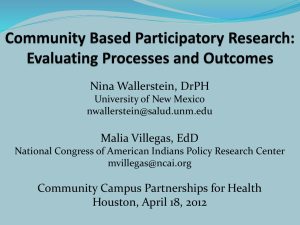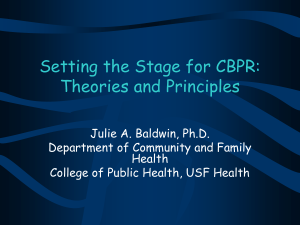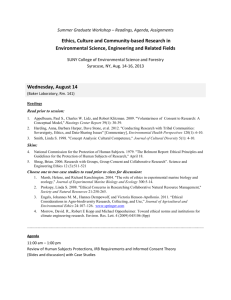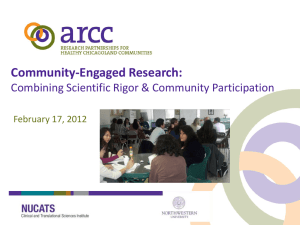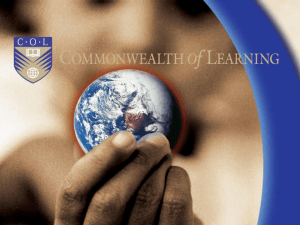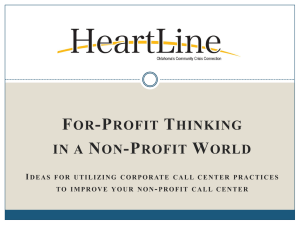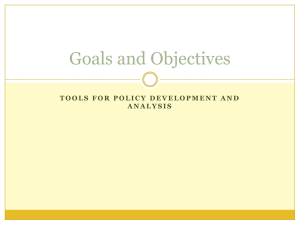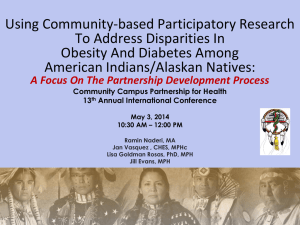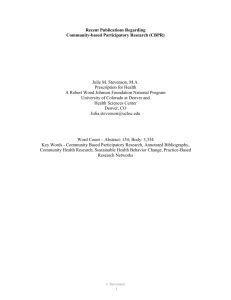Engaging the for-profit sector in CBPR
advertisement
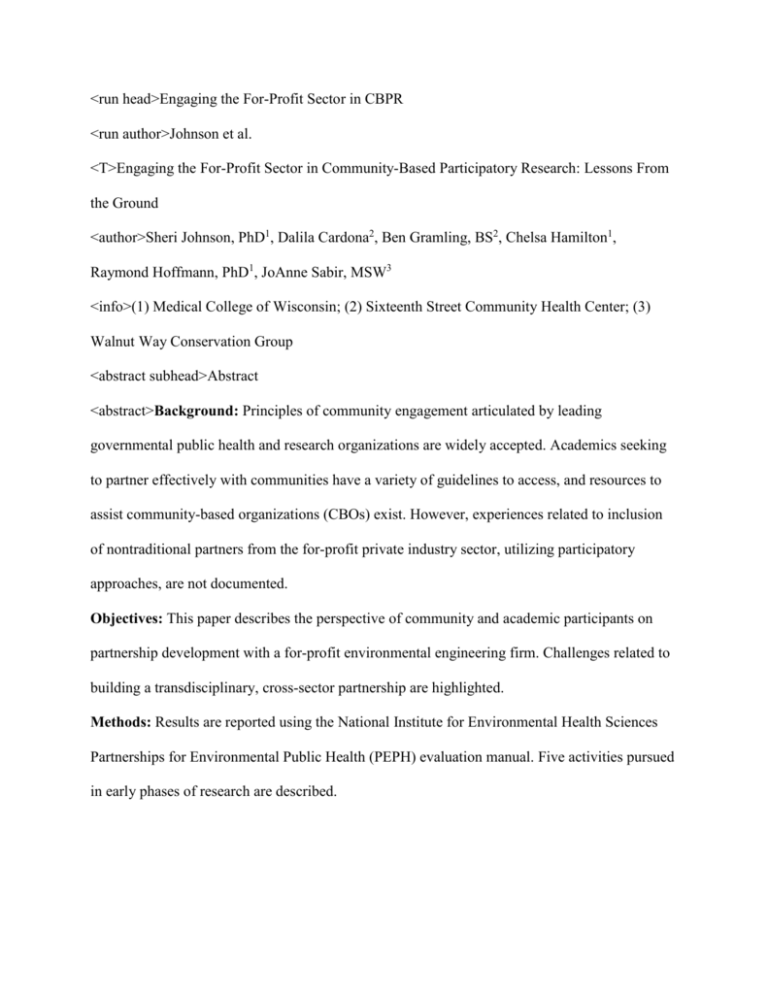
<run head>Engaging the For-Profit Sector in CBPR <run author>Johnson et al. <T>Engaging the For-Profit Sector in Community-Based Participatory Research: Lessons From the Ground <author>Sheri Johnson, PhD1, Dalila Cardona2, Ben Gramling, BS2, Chelsa Hamilton1, Raymond Hoffmann, PhD1, JoAnne Sabir, MSW3 <info>(1) Medical College of Wisconsin; (2) Sixteenth Street Community Health Center; (3) Walnut Way Conservation Group <abstract subhead>Abstract <abstract>Background: Principles of community engagement articulated by leading governmental public health and research organizations are widely accepted. Academics seeking to partner effectively with communities have a variety of guidelines to access, and resources to assist community-based organizations (CBOs) exist. However, experiences related to inclusion of nontraditional partners from the for-profit private industry sector, utilizing participatory approaches, are not documented. Objectives: This paper describes the perspective of community and academic participants on partnership development with a for-profit environmental engineering firm. Challenges related to building a transdisciplinary, cross-sector partnership are highlighted. Methods: Results are reported using the National Institute for Environmental Health Sciences Partnerships for Environmental Public Health (PEPH) evaluation manual. Five activities pursued in early phases of research are described. Conclusions: Community members and scholars recognize that complex public health problems warrant transdisciplinary and cross-sector effort. Efforts to build CBPR partnerships with forprofit industry may benefit from a stepwise approach. <abstract subhead>Keywords <abstract>Community-based participatory research, environmental health, partnerships, forprofit, gardening, research pilot projects <info>Submitted 31 October 2012, revised 17 June 2013, accepted 2 July 2013 <info>This publication was also supported by the National Center of Research Resources and National Center for Advancing Translational Sciences, National Institutes of Health, through grant number 8UK1TR000055. <N>Principles for community engagement articulated by leading governmental public health and research organizations are widely accepted.1 Community-based participatory research (CBPR), located within the spectrum of community-engaged research, emphasizes local relevance, making it well matched to initiatives that emerge through the course of neighborhood development. Partnerships with academics that bring complementary assets may strengthen projects that originate with a “place-based” frame for exploring the dynamic interplay between individual, relational, community, and environmental factors that foster health. Indeed, the CBPR literature contains numerous examples of ventures linking not-for-profit, CBOs and academic institutions to address health concerns in an identified population.2 Academic institutions seeking to partner effectively with communities have a variety of guidelines and specific advice to access regarding the etiquette of community engagement.3 Similarly, resources exist to assist CBOs contemplating pursuit of relationships with universitybased researchers.4 However, experiences related to inclusion of nontraditional partners, particularly those from the for-profit private industry sector, are not documented in the medical or social science literature. Searches in Ovid-Medline, PsycINFO, and PubMed yielded no results related to integrating private, for-profit entities into CBPR projects. CBPR builds a mechanism for translating research results into action, fostering community capacity to solve health problems through programmatic, policy, and social change.5 As communities gain internal health-promoting resources, reliance on academic or industry partners for technical expertise may diminish. Yet, the goal that CBPR scholars acknowledge, at least theoretically, of “putting ourselves out of business” may be incompatible with the aims of for-profit industry experts. Efforts to engage in this type of cross-sector collaboration, utilizing participatory approaches, are not yet fully described or understood. <A>Objectives <N>This paper describes the process of partnership development between two CBOs, academia and a private, for-profit environmental engineering firm to study the relationship between residential urban vegetable gardening and lead exposure. Childhood lead poisoning remains a serious public health problem. Recent studies suggest that blood lead levels as low as 2 μg/dL are associated with subtle intellectual impairment in children and long-term effects apparent in adulthood.6-10 Research demonstrates that moderate lead levels negatively impact student’s proficiency on standardized tests.11 Because increased participation in urban gardening as a result of local food movements is likely, exposure risk from impacted soil and consumable plant tissue may increase.12,13 Yet, limited knowledge exists about utilization of safe gardening recommendations developed by government agencies, community organizations, and educational institutions. Therefore, leveraging the expertise of community residents, organizations, and private sector experts in designing and implementing research may increase the effectiveness of environmental health interventions. A participatory research approach expands community residents’ knowledge and enables more informed decisions about the risks and benefits of urban residential gardening. Consistent with an action research agenda, gains in practical expertise do matter.14 Our pilot research responds to both community identified and national health priorities. Community-based programming focused on gardening, healthy food access, and childhood lead poisoning prevention predates this research. Neighborhood assessment and planning efforts document comprehensive revitalization strategies, including priorities to increase healthy eating and promote environmental education.15,16 In addition, a renewed federal appeal for primary prevention research focuses on the adoption of prevention strategies to reduce environmental lead exposures in soil.17-19 This paper highlights challenges related to building a transdisciplinary, cross-sector partnership. It represents the consensus of academic and CBO participants, but may not adequately capture the perspective of the for-profit industry. The for-profit industry representative contributed to a peer-reviewed abstract that broadly outlined partnership formation issues. However, the firm indicated a need to be compensated for time spent in review and revision of the manuscript that followed the abstract, which was not possible. This limitation is significant. However, given the dearth of information related to engaging for-profit industry experts in CBPR, the restricted perspective presented offers important insights for others considering related approaches. <A>Methods <N>The project emerged from existing and newly forming relationships between individuals and organizations. Two CBOs, a private for-profit environmental engineering firm, and faculty/staff from the community unit of a Children’s Environmental Health Sciences Core Center began discussions about shared interests in urban agriculture and applied environmental research. Initial formal conversations began through a community driven forum known as the E.A.R.T.H committee (Environmental Applied Research to Improve Health) hosted by one of the CBOs with a history of involvement in urban gardening and a commitment to furthering the interests of neighborhood residents through research. Synergistic knowledge and concern regarding lead concentration in urban residential soils, lead uptake in vegetables grown in urban soils, and sociocultural factors related to gardening practices arose. A faculty partner with community engagement experience was identified to serve as principal investigator (PI) and we sought pilot funding. The first submission was rejected. Investment in the project, based in part on a commitment to carry forward the desire of neighborhood residents, resulted in agreement to continue to work together. A serendipitous opportunity to apply for a “pre-pilot” grant arose, resulting in a successful proposal focused on proving feasibility. A full pilot grant followed. Results are reported according to the approach recommended by the National Institute for Environmental Health Sciences PEPH evaluation metrics manual.20 Although this research started before publication of the PEPH guidelines, other authors utilized retrospective review to describe partnership processes.21 The PEPH manual identifies five broad activities related to partnership development: Identify partners, build relationships, involve partners, communicate clearly, and maintain and improve partnership processes. Each of these subsumes several potential metrics, which are program measures (i.e., quantity, frequency) reported systematically to describe performance toward goals.20 The logic model (Figure 1) provides a framework for describing partnership development in terms of selected activities and outputs (or results). The paper presents five activities, utilizing eight metrics, pursued in the pre-pilot and early pilot research phases. We utilized multiple sources of data to support the results, including meeting agendas and notes compiled by the PI and research coordinator, electronic documents, organizational websites and materials, and project-specific materials. <T>Figure 1 <A>Results Figure 2 is a timeline of partnership development with key events noted, including approval from the Institutional Review Board at the Medical College of Wisconsin. <T>Figure 2 <B>Activity 1: Identify Partners <N> Number of Partners Identified. Primary participants in the pre-pilot phase included nine individuals from four organizations (two CBOs, a local environmental engineering firm, and a local private medical school). The CBOs (Walnut Way Conservation Corp [WWCC] and Sixteenth Street Community Health Center) each serve a geographically defined area. WWCC’s resident-driven program planning and implementation focuses on experiential educational initiatives that inform and engage youth and adult residents in civic and community leadership, housing construction and restoration, stewardship of environmental resources, and economic development. WWCC residents and volunteers have 5 years of successful experience in urban ecology–based initiatives. Sixteenth Street Community Health Center started working on environmental health initiatives in 1993 by providing clinic patients and community members with useful information and action steps to minimize or eliminate health risks from exposure to urban environmental hazards. Childhood exposure to environmental lead has been a longstanding focus. The Sixteenth Street Community Health Center also works with public, private, and nonprofit sector partners to identify and advance comprehensive neighborhood development and environmental remediation strategies. A private environmental engineering and consulting firm with more than 20 years of experience expressed interest in contributing to research related to lead concentrations in residential soils and uptake in consumable plants. Brownfield redevelopment represents one area of capability that the firm’s staff of engineers, scientists, and regulatory experts offers. Previous experience with public sector projects, including assistance with grant writing to obtain funds for neighborhood revitalization, indicated the potential for significant contributions to long-term goals identified in community planning efforts. A senior project scientist led the firm’s engagement in the project. Academic partners made up one third of the primary participants and community and industry partners were two thirds of the primary participants during the pre-pilot phase. The balance between community, industry, and academic participants remained stable, although individuals and roles among the CBO staff changed. <B>Activity 2: Build Relationships <N> Formal Partnership Agreement. Participants initiated activities regarding identifying shared principles for engagement during the pre-pilot stage (January to March 2011). The PI provided an orientation to CBPR and participants reviewed templates for partnership agreements and sample memoranda of understanding. The PI attended a workshop on partnership formation facilitated by a CBO partner with substantial experience in community–academic collaboration. Discussion of partnership principles continued over 18 months. Items related to partnership formation appeared on the monthly research team agenda 12 times. In addition, dialogue between various research team members, including the industry representative, occurred outside of scheduled meetings. From the perspective the community and academic participants, it seemed that the industry representative struggled to understand the purpose and nature of a partnership agreement, as distinguished from a contract negotiated to perform a scope of work. Attempts to articulate a partnership role for industry not directly tied to funding were unsuccessful. Issues related to data ownership and provision of “in-kind” resources also surfaced divergent perspectives. Achieving mutual understanding regarding the value of community participation in research did not occur. The “pre-pilot” funds required that the partners simultaneously perform research tasks (i.e., recruit participants) while negotiating principles of partnership, which impacted the process. Ultimately, the firm opted not to join the partnership, but continued to function as a consultant until June 2012. <B>Activity 3: Involve Partners <N> Hours Partners Participated in Research. The primary team met during the pre-pilot period for biweekly, face-to-face meetings scheduled for 2.5 hours, and hosted at the industry offices. Partners did not maintain formal attendance logs, but seven of the nine primary partners attended on a regular basis. The option to teleconference utilized primarily by one of the academics enhanced meeting attendance. The research team continued meeting during a 4-month gap between funded grant periods. Monthly, 1.5-hour, face-to-face meetings began upon notification of pilot funding. During the pilot phase, the meeting location rotated to facilitate attendance for all participants equally. Partners’ Contributions to Research. The primary aims and hypotheses developed collaboratively and utilized the transdisciplinary expertise assembled. All major tasks benefited from input from the entire research team. Overlapping experience between industry and community-based staff, especially related to Brownfield remediation, provided some shared platform for collaboration. Iterative processes involving community residents, CBO staff, and academic and industry participants produced knowledge relevant to local priorities. Industry led three tasks specific to environmental site assessment: Consultation with a regional regulatory agency regarding reporting requirements for environmental spills; development of a soil and plant sampling decision tree based on legal, regulatory and ethical parameters; and development of a Sampling Analysis and Quality Assurance Project Plan. CBOs headed efforts in three areas. Staff compiled neighborhood-specific data describing the overall make-up of the selected communities, as well as specific data regarding housing and lead poisoning prevalence rates. Additionally, staff prepared written community education materials based on published recommendations for safe urban gardening and childhood lead poisoning prevention in English and Spanish.22 Last, CBOs recruited neighborhood residents for participation in structured interviews and member feedback sessions, conducted structured interviews and co-facilitated member feedback sessions. The academic partners directed three major tasks. They developed a structured interview guide assessing gardening practices (with consultation from a campus-based ethnographer) and trained CBO staff to conduct interviews and feedback sessions. The biostatistician developed the sampling approaches. Finally, the academics provided administrative oversight, including compliance with institutional review board requirements. <B>Activity 4: Communicate Clearly with Partners <N> Ensure Bidirectional Communication. Communication occurred via several channels including email, in-person meetings, a shared secure document storage site, and teleconference. Partners established consensus regarding the importance of regular, face-to-face meetings among the primary research team members. Nonetheless, communication challenges arose. The need for lengthy discussions outside of face-to-face meetings, to build trust and mutual understanding of domain-specific, organizational, and individual perspectives created challenges in balancing transparency and confidentiality. Periodic absences of primary partners at scheduled meetings necessitated review of prior discussions, resulting in some misunderstanding and frustration. <B>Activity 5: Maintain and Improve Partnership Processes <N> Number/Description of Partners Retained. The four organizational entities who initiated the research remained actively involved for a total of 29 months (only 13 months funded). Stability among individual participants was not as high; 6 of 17 persons who contributed to the project remained active throughout the pre-pilot and early pilot phases. Five personnel changes resulted from employee departures from their respective organizations. Number/Description of Partners Who Cycle Out. The private environmental engineering firm ended its involvement after 29 months (February 2010 to June 2012) invested in partnership formation and early research implementation. The sampling and quality assurance plan prepared by the firm during the pre-pilot phase provided a basis for the research operations manual utilized for soil and plant sampling and analysis. The primary barrier that prevented continued engagement related to contractual issues associated with federal (National Institutes of Health) audit requirements for establishment of indirect cost rates. Several contractual mechanisms were considered over an 11-month period (August 2011 to June 2012). During that time, the industry representative remained at the table and all of the partners expected resolution to allow continued, funded participation. However, no contractual options available sufficiently met the requirements of both the funder and the firm. Community and academic partners perceived secondary concerns that also challenged the success of the cross-sector partnership with for-profit industry. Expectations for significant “inkind” investments of industry staff time to participate in a CBPR study became more difficult as the project progressed. The amount of time needed to conceptualize and craft a written partnership agreement competed with time pressure to implement other components of the research design, such as recruitment of neighborhood residents for soil and plant sampling. Engagement with community organizations and residents in a co-equal manner required that details of study design and implementation include perspectives not traditionally considered. Each of these challenged the community, academic, and industry participants’ ability to navigate the research process. Number/Description of Partners Added. Two neighborhood residents who participated in interviews and member feedback sessions in the pre-pilot research joined the research team upon award of pilot funds. One individual became staff at WWCC. Language barriers made full participation in the research meetings difficult for the other community resident. Despite bilingual staff committed to meeting preparation time with the community resident, translation during research meetings and post-meeting debriefing, meaningful participation was thwarted. However, small, task-focused meetings allowed for more substantive input. Because of the discontinuation of industry involvement, remaining partners and the funder identified the need for expertise in environmental health and soil science to fully address the aims of the pilot study. Through established relationships between the CBOs and other academic institutions in the region, we identified an experienced faculty partner from another university to complete the project. <A>Conclusion <N>Over a period of 29 months, the collaboration between CBOs, academia, and for-profit industry experienced challenges and ultimately failed with regard to developing and sustaining a partnership. Lessons learned from the vantage point of community and academic partners regarding the process of engaging a nontraditional entity in CBPR may apply to other initiatives. First, despite the failure to fully execute a partnership with a for-profit environmental engineering firm, community and academic partners gained valuable insight regarding the importance of building on identified strengths and resources. The industry partner’s exit required that we quickly generate and build consensus around a revised implementation strategy. Because of thriving networks built by the CBOs and regional academic institutions, we quickly identified university-based soil science experts who performed the vacated scope of services related to soil and plant collection and analysis. Cost-savings that occurred resulted in an opportunity to further invest in community-based research team member’s skill development, specifically in lead source sampling. Success in leveraging these relationships validated the importance of maintaining our commitment to building community capacity as part of CBPR. Second, we learned that clearly identifying the expectations and rewards of CBPR may not completely fortify newcomers for the inevitable struggles inherent in the long-term process required to shift power relationships and promote community capacity. In our experience, the representative from for-profit industry came to the table prepared to utilize business practices that reflect the exigencies of success in that world. “Budget, scope, schedule” was the default mantra for the industry representative. Although nonprofit CBOs and academic institutions are bound by similar constraints, the flow and aims of CBPR requires both flexibility and commitment. The expectation of effort above and beyond funding, contracts, and timelines, sets CBPR apart from traditional approaches. Stoecker asserts that, “‘doing research’ is not, in itself a goal” in CBPR.23 Instead, social change through acquisition of new knowledge and skills, relationships of solidarity and action toward community-level sufficiency are intended. Yet, articulation of a shared vision for social change is a formidable process, even among seasoned partners. Language and cultural diversity among partners requires intentional action to foster equal participation, which may necessitate skills less emphasized in the for-profit sector. It is difficult, if not impossible, to pre-calculate the amount of time required for transformation towards the embrace of a social change agenda to occur. The CBPR literature consistently identifies time investment and funding as major challenges.24 Thus, a potential first step toward building partnerships with a for-profit entity suggests a narrower role for industry, a role as a consultant with technical knowledge to contribute. Based on success in that limited capacity, a more robust partnership that reflects mutually agreeable values, goals, and processes for engagement warrants exploration. In summary, community members and scholars have long recognized that complex, seemingly intractable public health problems require multilevel solutions. Leveraging expertise from within communities, while building partnerships across disciplines and sectors, however, is easier said than done. Significant “up-front” investments are required and do not guarantee the desired outcomes. Further characterization of the potential costs and benefits of engaging forprofit industry experts in CBPR from others in the field will add to current understanding. Additional perspective from industry representatives regarding methods to overcome barriers related to partnership development in the context of CBPR increases the chances for future success. <A>Acknowledgements <N>The pilot project described in this publication was supported by the National Institute of Environmental Health Sciences under award number ES-04184. Publication contents are solely the responsibility of the authors and do not necessarily represent the official views of the National Institutes of Health. The authors acknowledge Sharon Adams, Andrea Fuentes, Jo Ann Gray-Murray, Charlotte Litgens, Nicole Lightwine, Kimberly Njoroge, and the community residents in the two project neighborhoods. <A>References 1. Clinical and Translational Science Awards Consortium Community Engagement Key Function Committee Task Force on the Principles of Community Engagement. Principles of community engagement. 2nd ed. NIH Publication No. 11-7782. Washington (DC): National Institutes of Health; 2011. 2. Viswanathan M, Ammerman A, Eng E, Gartlehner G, Griffith, D, Rhodes . et. al. Community-based participatory research: Assessing the evidence. AHRQ Publication 04-E0222. Rockville (MD): Agency for Healthcare Research and Quality; 2004. 3. Michener L, Cook J, Ahmed SM, Yonas MA, Coyne-Beasley T, Aguilar-Gaxiola S. Aligning the goals of community-engaged research: Why and how academic health centers can successfully engage with communities to improve health. Acad Med. 2012;87(3):258-91. 4. Community-Campus Partnership’s for Health. Community-campus partnerships for health: Promoting health equity and social justice [cited 2012 Oct 31]. Available from: http://www.ccph.info 5. Isreal BA, Eng E, Schulz AJ, Parker EA, editors. Methods in community-based participatory research. San Francisco: Jossey-Bass; 2005. 6. Bellinger DC, Needleman HL. Intellectual impairment and blood lead levels. N Engl J Med. 2003;349(5):500. 7. Canfield RL, Henderson CR, Lanphear BP. Intellectual impairment and blood lead levels - Reply. N Engl J Med. 2003;349(5):501-2. 8. Canfield RL, Kreher DA, Cornwell C, Henderson CR. Low-level lead exposure, executive functioning, and learning in early childhood. Child Neuropsych. 2003;9(1):35-53. 9. Canfield RL, Henderson CR, Cory-Slechta DA, Cox C, Jusko TA, Lanphear BP. Intellectual impairment in children with blood lead concentrations below 10 mu g per deciliter. N Engl J Med. 2003;348(16):1517-26. 10. Needleman HL, Schell A, Bellinger D, Leviton A, Allred EN. The long-term effects of exposure to low doses of lead in childhood. An 11-year follow-up report. N Engl J Med. 1990;322(2):83-8. 11. Amato MS, Moore CF, Magzamen S, Imm P, Havlena JA, Anderson HA. Lead exposure and educational proficients: Moderate lead exposure and educational proficiency on end-of-grade examinations. Ann Epidemiol. 2012;22(10):738-43. 12. Allen W. The good food revolution: Growing healthy food, people, and communities. New York: Gotham Books; 2012. 13. Burger J, Gochfald M. Conceptual environmental justice model for evaluating chemical pathways of exposure in low-income, minority, Native American, and other unique exposure populations. Am J Public Health. 2011;101 Suppl 1:S64-73. 14. Bradbury H, Reason P. Issues and choice points for improving the quality of action research. In: Minkler M, Wallerstein N, editors. Community-based participatory research for health: from process to outcomes. 2nd ed. New York: Jossey-Bass; 2008. p. 225-42. 15. Groundwork Milwaukee. A vision for the Kinnickinnic River trail corridor [cited 2013 Apr 24]. Available from: http://www.groundworkmke.org/pdf/kk.pdf 16. Zilber Neighborhood Initiative. Lindsay Heights: Quality of life plan [cited 2013 Apr 24]. Available from: http://www.znimilwaukee.org/assets/files/ZNI_QLP_Full_LindsayHts.pdf 17. Advisory Committee on Childhood Lead Poisoning Prevention of the Centers for Disease Control and Prevention. Low level lead exposure harms children: A renewed call for primary prevention [cited 2012 Oct 25]. Available from: http://www.cdc.gov/nceh/lead/ACCLPP/Final_Document_030712.pdf 18. Centers for Disease Control and Prevention. Announcement: Response to the advisory committee on childhood lead poisoning prevention report, low level lead exposure harms children: A renewed call for primary prevention. MMWR Morb Mortal Wkly Rep. 2012;61(20):383. 19. Betts KS. CDC updates guidelines for children’s lead exposure. Environ Health Perspect. 2012;129(7):a268. 20. National Institute of Environmental Health Services. Partnerships for environmental public health: Evaluation metrics manual. NIH Publication No. 12-7825.2012. Washington (DC): National Institutes of Health. 21. Brown VJ. Are we on the same page? Action agenda of the national conversation on public health and chemical exposures. Environ Health Perspect. 2011;120(4):484-7. 22. United States Environmental Protection Agency. Brownfields and urban agriculture: Interim guidelines for safe gardening practices. EPA 560/S-11/001. Washington (DC): Environmental Protection Agency; 2011. 23. Stoecker R. Are academics irrelevant? Approaches and roles for scholars in CBPR. In Minkler M, Wallerstein N, editors. Community-based participatory research for health: From process to outcomes. 2nd ed. New York: Jossey Bass; 2008:108-20. 24. Israel BA, Krieger J, Vlahov D, Ciske S, Foley M, Fortin P, et al. Challenges and facilitating factors in sustaining community-based participatory research partnerships: Lessons from the Detroit, New York City and Seattle Urban Research Centers. J Urban Health. 2006;83(6):1022-40. <table number>Figure 1. <table title>Partnership for environmental public health partnership logic model. (Source: National Institute of Environmental Health Sciences. U.S. Department of Health and Human Services [2012]. Partnerships for Environmental Public Health Evaluation Metrics Manual. NIH Publication No. 12-7825. Available: http://www.niehs.nih.gov/pephmetrics.) <table Number>Figure 2. <table title>Partnership timeline.
